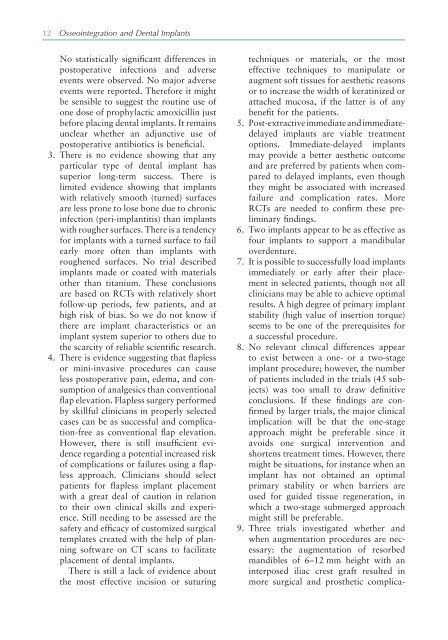Untitled - Link 1 Link 16 Link 2 Link 17 Link 3 Link 18 Link 4 Link 19 ...
Untitled - Link 1 Link 16 Link 2 Link 17 Link 3 Link 18 Link 4 Link 19 ...
Untitled - Link 1 Link 16 Link 2 Link 17 Link 3 Link 18 Link 4 Link 19 ...
You also want an ePaper? Increase the reach of your titles
YUMPU automatically turns print PDFs into web optimized ePapers that Google loves.
12 Osseointegration and Dental Implants<br />
No statistically signifi cant differences in<br />
postoperative infections and adverse<br />
events were observed. No major adverse<br />
events were reported. Therefore it might<br />
be sensible to suggest the routine use of<br />
one dose of prophylactic amoxicillin just<br />
before placing dental implants. It remains<br />
unclear whether an adjunctive use of<br />
postoperative antibiotics is benefi cial.<br />
3. There is no evidence showing that any<br />
particular type of dental implant has<br />
superior long-term success. There is<br />
limited evidence showing that implants<br />
with relatively smooth (turned) surfaces<br />
are less prone to lose bone due to chronic<br />
infection (peri-implantitis) than implants<br />
with rougher surfaces. There is a tendency<br />
for implants with a turned surface to fail<br />
early more often than implants with<br />
roughened surfaces. No trial described<br />
implants made or coated with materials<br />
other than titanium. These conclusions<br />
are based on RCTs with relatively short<br />
follow-up periods, few patients, and at<br />
high risk of bias. So we do not know if<br />
there are implant characteristics or an<br />
implant system superior to others due to<br />
the scarcity of reliable scientifi c research.<br />
4. There is evidence suggesting that fl apless<br />
or mini-invasive procedures can cause<br />
less postoperative pain, edema, and consumption<br />
of analgesics than conventional<br />
fl ap elevation. Flapless surgery performed<br />
by skillful clinicians in properly selected<br />
cases can be as successful and complication-free<br />
as conventional fl ap elevation.<br />
However, there is still insuffi cient evidence<br />
regarding a potential increased risk<br />
of complications or failures using a fl apless<br />
approach. Clinicians should select<br />
patients for fl apless implant placement<br />
with a great deal of caution in relation<br />
to their own clinical skills and experience.<br />
Still needing to be assessed are the<br />
safety and effi cacy of customized surgical<br />
templates created with the help of planning<br />
software on CT scans to facilitate<br />
placement of dental implants.<br />
There is still a lack of evidence about<br />
the most effective incision or suturing<br />
techniques or materials, or the most<br />
effective techniques to manipulate or<br />
augment soft tissues for aesthetic reasons<br />
or to increase the width of keratinized or<br />
attached mucosa, if the latter is of any<br />
benefi t for the patients.<br />
5. Post-extractive immediate and immediatedelayed<br />
implants are viable treatment<br />
options. Immediate-delayed implants<br />
may provide a better aesthetic outcome<br />
and are preferred by patients when compared<br />
to delayed implants, even though<br />
they might be associated with increased<br />
failure and complication rates. More<br />
RCTs are needed to confi rm these preliminary<br />
fi ndings.<br />
6. Two implants appear to be as effective as<br />
four implants to support a mandibular<br />
overdenture.<br />
7. It is possible to successfully load implants<br />
immediately or early after their placement<br />
in selected patients, though not all<br />
clinicians may be able to achieve optimal<br />
results. A high degree of primary implant<br />
stability (high value of insertion torque)<br />
seems to be one of the prerequisites for<br />
a successful procedure.<br />
8. No relevant clinical differences appear<br />
to exist between a one- or a two-stage<br />
implant procedure; however, the number<br />
of patients included in the trials (45 subjects)<br />
was too small to draw defi nitive<br />
conclusions. If these fi ndings are confi<br />
rmed by larger trials, the major clinical<br />
implication will be that the one-stage<br />
approach might be preferable since it<br />
avoids one surgical intervention and<br />
shortens treatment times. However, there<br />
might be situations, for instance when an<br />
implant has not obtained an optimal<br />
primary stability or when barriers are<br />
used for guided tissue regeneration, in<br />
which a two-stage submerged approach<br />
might still be preferable.<br />
9. Three trials investigated whether and<br />
when augmentation procedures are necessary:<br />
the augmentation of resorbed<br />
mandibles of 6–12 mm height with an<br />
interposed iliac crest graft resulted in<br />
more surgical and prosthetic complica-


